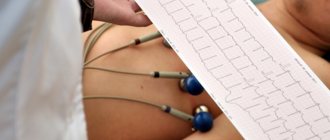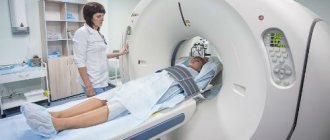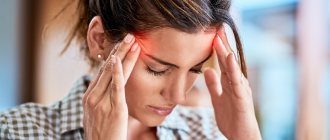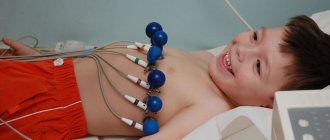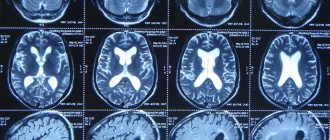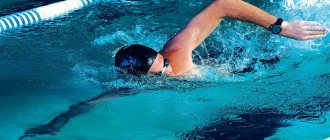What heart diseases are suspected?
Myocardial infarction
The most frightening diagnosis for a person who feels pain in the heart area is myocardial infarction.
It is the death of living tissues of the body as a result of an acute deficiency of oxygen and nutrients. This condition develops due to impaired blood flow due to blockage of the vessel. A short pause is enough for a heart attack to occur. The dead part of the organ ceases to perform its function. The more important it is, the more severe the consequences will be. Most often, myocardial infarction is caused by thrombi - blood clots that interrupt the normal flow of blood in the vessels. Leading symptoms in this condition:
- pressing palpable pain and burning in the chest;
- it becomes difficult to breathe;
- profuse release of sticky cold sweat;
- the pain is localized not only on the left side, but also in the center of the chest;
- pain is transmitted to the lower jaw, as well as the neck, shoulders, back or left arm;
- dizzy;
- the heart rhythm is lost (or becomes frequent);
- the face acquires a bluish tint;
- a person feels a panicky fear of death.
This condition can last from several minutes to a couple of hours, depending on the time of arrival of the ambulance team. Nitroglycerin tablets do not work.
Myocarditis
Myocarditis is a disease in which the inflammatory process affects the myocardium. Caused by infectious agents in the form of bacteria, viruses, fungi. In this case, the heart can hurt in different ways. More often there is aching, cutting, stabbing or squeezing sensations.
There are other signs of pathology:
- frequent heart contractions;
- high body temperature;
- lack of air;
- attacks of weakness;
- feeling tired after minor exertion;
- feeling of “freezing in the heart.”
The pressing pain with myocarditis is paroxysmal, disturbing several times a day. Nitroglycerin does not alleviate the condition.
Heart defects
The cause of pain may be a heart defect. Both congenital and acquired.
In the initial phase of the anomaly, the heart copes with its work, especially under moderate loads ( compensation ). Then comes a stage at which the organ cannot function normally during physical activity, and the initial signs of the disease appear ( subcompensation ). This is followed by the most dangerous period, when discomfort and symptoms occur regularly as part of normal life activities. In this phase ( decompensation ), pressing pain may appear even in sleep.
Other symptoms of heart disease:
- tachycardia;
- dizziness;
- swelling of the lower extremities;
- difficulty breathing with the slightest exertion;
- possible fainting;
- in the area of the heart, squeezing and distension are felt;
- redness of the facial skin;
- hoarseness when breathing.
Pathologies of this kind may have similar symptoms to other heart diseases, so only a doctor will make the correct diagnosis.
Angina pectoris
This condition appears more often in old age. It occurs due to a sharp decrease in oxygen supply to the myocardium due to spasm. Pressing pain in the heart during angina pectoris begins suddenly, provoking factors can be anxiety and stress, physical activity (even walking). The attack will end when the person has rested and calmed down. Nitroglycerin will help to quickly alleviate the condition. Other signs of angina pectoris:
- pain penetrates into the left arm or under the shoulder blade, into the lower jaw or neck;
- blood pressure increases;
- a symptom similar to heartburn appears; heat is felt in the chest.
The attacks are usually short-lived.
Pericarditis
Pericarditis is an inflammation of the outer lining of the heart of infectious origin. Pressing pain, which is long-lasting, is one of the main signs of pathology. Additional symptoms of the disease:
- prostration;
- temperature increase;
- non-standard localization of pain - on the right;
- bouts of dry, bloody cough.
Compressive pain in the chest during pericarditis does not go away after taking a Nitroglycerin tablet. Relief occurs when you change your body position: you need to sit down and bend forward.
Myocardiostrophy
This includes a whole group of cardiac pathologies, which are based on metabolic disorders within the heart muscle. At first there are barely noticeable, dull, pressing pains in the heart. Over time, they intensify and become quite noticeable.
Why does my heart hurt at night?
The connection between physical activity and an attack of angina is obvious. In response to the load, the pulse becomes faster, the heart vessels contract and the heart receives less blood, and with it oxygen, which is signaled by the appearance of squeezing and pressing pain in the chest. It is logical to assume that in a calm state, the delivery of oxygen to the heart muscle does not cause problems. Why then does “angina pectoris” come to lovers of passive recreation? Let's figure out what worries the heart in a dream.
An atypical type of angina was first noticed by American cardiologist Myron Prinzmetal in 1959. He described attacks of compressive chest pain at rest that caused temporary changes in the ECG, and called it “variant.” Later, the term was changed more than once: into Prinzmetal’s angina, angiospastic (from the Greek “angeion” - vessel), spontaneous (sudden), resting angina. Prinzmetal named the provocateur of the attack as a spasm (narrowing) of the large cardiac arteries, causing prolonged and intense pain in the chest. The attacks more often occurred at night or early in the morning and were accompanied by increased heart rate, arrhythmia, a drop in blood pressure, and even fainting.
Causes of night "noose"
The culprit of an unexpected spasm is often (not always!) atherosclerosis. In line to get the disease at a young age are heavy smokers, “malicious” untreated hypertensive patients, those with stomach ulcers, cholecystitis and even allergies. The connection between such different diseases is logical, given that they all disrupt the functioning of the autonomic nervous system, which is responsible for the constriction and dilation of blood vessels. Sometimes attacks of atypical angina occur from hypothermia or at the peak of emotions (release of stress hormones). But the most unpredictable variant of the course of the disease is the appearance of an attack for no reason.
Roller coaster that threatens lives
The differences between atypical angina and typical angina are in the strength, duration of the attack, which occurs at rest, and the accompanying vegetative manifestations (fast pulse, rhythm disturbances, including life-threatening ones, increased sweating, a feeling of trembling in the body). The time period when the attack occurs is also important. As a rule, the disease chooses the night-time hours, when the peak activity of the autonomic nervous system (and with it the unexpected surge of adrenaline) is maximum. During this period, the vessels are as relaxed as possible, which makes it difficult for them to adequately resist adrenaline.
What all attacks of atypical angina have in common is a sudden onset. The pain is most often pressing, cutting or burning, lasting 5-15 minutes (sometimes up to 30 minutes). Sometimes the attacks are serial in nature, occurring every 2-15 minutes. Outside of these attacks there may be no complaints at all. At the peak of chest pain, the adrenaline surge is similar in sensations to riding a roller coaster: the skin turns pale, becomes covered with sweat, the pulse quickens, headaches, nausea, and severe weakness occur as a result of changes in blood pressure (from 100/60 to 200/110 mm Hg! ). A rapid drop in pressure can result in fainting.
Rhythm disturbances often complement the pain syndrome at the time of an attack. In the best case, these are extrasystoles (and ventricular ones) or blockades of cardiac impulse conduction, in the worst case, life-threatening ventricular tachycardia or ventricular flutter. The latter, like an extensive myocardial infarction (a sharp vascular spasm completely blocks the access of blood and oxygen to the heart), complicated by a cardiac aneurysm, are fraught with sudden death.
The likelihood of complications developing is frightening in its unpredictability. An increase in the frequency and duration of attacks always worsens the prognosis. Damage to the heart vessels by atherosclerosis adds fuel to the fire, increasing the likelihood of sudden death to 25% per year. Clean heart vessels reduce this risk to 0.5% per year.
How to prove that angina is atypical
The main diagnostic sign of Prinzmetal's angina is changes in the ECG during a painful attack, which indicate ischemia of the heart muscle. As soon as the pain goes away, the tape shows the full normal. Alas, catching such changes on a standard ECG means sitting at the bedside of such a patient and painstakingly guarding his sleep. It is much easier to prove that the cause of the attack is a narrowing of the vessel, using Holter monitoring using an ECG (transient episodes of ischemia at night) or at the time of special provocative tests that cause a sharp narrowing of the heart vessels. But the “gold standard” of classical angina and its complications - stress tests (bicycle ergometry, treadmill test) and coronary angiography, on the contrary, will not detect serious disorders.
How to help a spasmodic vessel during an attack
Since pain when the lumen of a vessel narrows is always intense and long-lasting, the first step is to call an ambulance.
When providing emergency care to such a patient, one should not forget about the high risk of developing myocardial infarction:
- provide the patient with rest (optionally, sit him up in bed) and access to fresh air,
- take nitroglycerin under the tongue (tablets or capsules 0.5 mg; spray 10 g),
- Chew aspirin (not enteric form) or acetylsalicylic acid (0.5 mg tablets).
A specific drug for relieving vascular spasm is nifedipine 10 mg, taken sublingually. True, it should be taken with caution due to side effects (redness of the face, neck, increased heart rate, rhythm disturbances), so it would be better to ask a doctor about it.
Finally, a light massage of the face, back of the head, neck, shoulders, left half of the chest and knee joints will help to relieve the tension from the raging vegetative storm.
How to prevent vascular spasm in the future
It is better to treat Prinzmetal's angina in a hospital, and with tablets, and not with a surgeon's knife. To minimize the likelihood of another attack, it is advisable to eliminate the factors that provoke it: quit smoking and alcohol, normalize sleep, work and rest patterns, deal with “bad” cholesterol, engage in cardio training and, of course, take pills. The latter also dilate blood vessels, especially at night. These include the so-called calcium antagonists - amlodipine, cardillopine, norvasc, kalchek), verapamil or diltiazem. The first of them are best taken at night, the second - in the first half of the day or 2 times.
To ensure proper rest for the heart vessels, beta blockers are added to amlodipine.
Atypical angina definitely sets such a patient apart from the crowd of typical or “classic” ones. Alas, one fact remains unchanged - the risk of developing myocardial infarction. We should not forget that in an effort to save the heart from death, even non-standard approaches are sometimes acceptable.
Author: cardiologist at the clinic
Irina Lutik
Pressing chest pain due to non-cardiac problems
Other diseases that have nothing to do with the heart can masquerade as cardiovascular pathologies. For example:
- mental disorders;
- osteochondrosis, localized in the cervical or thoracic region;
- thoracic radiculitis;
- intervertebral hernia;
- digestive tract problems;
- pulmonary diseases;
- some skin diseases (herpes zoster);
- inflammation of intercostal cartilaginous tissues (Tietze syndrome);
- hormonal imbalances.
How do cardiac pain differ from non-cardiac pain? Cardiac ailments are accompanied by arrhythmias, white or bluish tint of the skin, shortness of breath, dizziness, fainting, attacks of nausea or vomiting, spreading of pain to the left forearm, back or lower jaw.
Mental disorders
- Depression.
A long-term nervous disorder characterized by apathy, lack of interest in life, indifference to oneself and the people around you. It can be caused by severe emotional shock. Pain in the heart can last for a long time and does not stop even at rest. They can radiate to the left side of the body, moving to the neck and shoulders.
- Vegetovascular dystonia.
One of the signs of the disease is frequent panic attacks. These are sudden and severe attacks of fear and panic, which are often unfounded. Compressive pain in the heart area is complemented by excessive sweating, tachycardia, weakness, chills, rapid breathing, high blood pressure, and tremor of the extremities.
- The presence of various phobias in a person.
Some people are afraid of closed or open spaces, others are afraid to be at heights, in the dark or in society. Cardiophobia is a constant fear of discovering that you have heart disease. Often experiences entail stimulation of the nervous system and pressing pain in the chest area.
- Hypochondria.
This is another type of neurosis in which a person is constantly looking for various diseases and pathologies. He imagines something that is not really there. Pain occurs when experiencing.
- Cardioneurosis.
A condition that can be called false angina. All symptoms are similar. A distinctive feature is difficulties during swallowing movements (as if a lump is stuck in the throat). Cardioneurosis is easily eliminated with sedatives; Nitroglycerin does not help.
Physical illnesses
- Osteochondrosis.
This disease manifests itself as pressing pain between the shoulder blades, which extends to the heart, arms, shoulders, and neck. A tingling sensation is often felt in the skin. Pain appears when a person makes sudden movements with his head or arms. Discomfort is also felt in a long static position. At night the condition may worsen. Read more about how not to confuse osteochondrosis with heart problems here.
- Thoracic radiculitis.
This disease belongs to the peripheral nervous system disorders. The pain is pressing, can be constant or occur in the form of attacks. Localized in the intercostal space, passes to the thoracic region. Painful sensations become stronger with light pressure on the ribs, as well as during sneezing, coughing or movement.
- Intervertebral hernia.
The cartilage between the spinal discs can age and degrade. In this case, pinched nerves occur, which leads to acute, pinching pain in the chest, when it is difficult to inhale and exhale. The symptoms are very similar to angina pectoris. There is muscle weakness, arms and back go numb, and “goosebumps crawl” on the skin. The pain is paroxysmal in nature.
- Digestive tract problems.
When the abdomen is bloated, accumulated gases begin to compress the internal organs. In this case, pressing pain appears in the thoracic region. It is cramping in nature. This symptom is difficult to confuse with a heart sign, since it is accompanied by digestive disorders: heaviness in the stomach, rumbling, heartburn or belching.
- Heartburn.
This symptom can cause discomfort in the heart area. The pain usually occurs while eating, bending or lying down. There are other manifestations: a burning sensation in the chest, belching with a taste of acid.
- Pulmonary diseases.
Pleurisy. Inflammatory process of the pulmonary membranes that line the organ from the inside. Chest pain is pressing, sharp, increases when coughing or taking a deep breath. The pain decreases slightly if you lie on your right side and do not move. In this case, you need to breathe shallowly. In this state, you may feel chills and sweat.
- Pulmonary embolism.
Acute pain occurs, similar to pre-infarction pain. In addition, you may notice blueness or excessive pallor of the face, difficulty breathing, severe weakness that ends in fainting, weak pulse, and hemoptysis. The cause of the pathology is the formation of a blood clot that blocks the movement of blood in the pulmonary arteries.
- Shingles.
The disease is caused by the herpes virus. A rash spreads across the skin, often localized to the ribs. The nerve endings in this place are affected by infection, so a rise in temperature is possible.
- Tietze syndrome.
Inflammation of the cartilage of the intercostal space. This process is accompanied by severe, sudden pain in the chest area, which becomes more intense when pressing on the rib.
